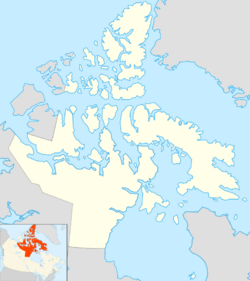Susanna Island facts for kids
| Geography | |
|---|---|
| Location | Gulf of Boothia |
| Coordinates | 70°29′N 091°57′W / 70.483°N 91.950°W |
| Archipelago | Canadian Arctic Archipelago |
| Administration | |
| Territory | Nunavut |
| Region | Kitikmeot |
| Demographics | |
| Population | Uninhabited |
Susanna Island is a small, uninhabited island located in the far north of Canada. It is part of Nunavut, a large territory in the Arctic. This island is found in the eastern part of the Gulf of Boothia.
Susanna Island is quite close to the mainland's Boothia Peninsula. It is also about 8.5 kilometers (5.3 miles) southeast of a larger island called Pouncet Island.
Contents
Where is Susanna Island Located?
Susanna Island is situated in the Kitikmeot Region of Nunavut. This region is in the northern part of the Canadian Arctic Archipelago. The Canadian Arctic Archipelago is a huge group of islands in the Arctic Ocean.
Understanding the Gulf of Boothia
The Gulf of Boothia is a large body of water in the Canadian Arctic. It is surrounded by land on three sides, including the Boothia Peninsula. This gulf connects to other important waterways in the Arctic.
What is the Canadian Arctic Archipelago?
The Canadian Arctic Archipelago is one of the largest archipelagos (groups of islands) in the world. It includes thousands of islands, big and small. These islands are mostly covered in ice and tundra.
Life on an Uninhabited Arctic Island
Susanna Island is uninhabited, meaning no people live there permanently. This is common for many small islands in the Arctic. The harsh climate makes it difficult for humans to settle.
The Arctic Climate
The Arctic has a very cold climate. Winters are long and dark, with temperatures often dropping far below freezing. Summers are short and cool, with continuous daylight for part of the season. The ground is often covered by permafrost, which is permanently frozen soil.
Wildlife in the Arctic
Even though Susanna Island is uninhabited by humans, it might be visited by various Arctic animals. These animals are adapted to the cold environment.
Marine Animals
The waters around Susanna Island are home to marine mammals. Ringed seals and bearded seals are common. These seals are an important food source for polar bears.
Land Animals
Polar bears are powerful predators that roam the Arctic. They often travel across sea ice and islands in search of food. Other animals like Arctic foxes might also be found on or near the island.
Birds of the Arctic
Many types of birds migrate to the Arctic during the summer months. They come to nest and raise their young. Seabirds often use remote islands like Susanna Island as safe breeding grounds.
Why are Arctic Islands Important?
Arctic islands like Susanna Island play a role in the global ecosystem. They are important habitats for wildlife. They also help scientists study climate change.
Studying Climate Change
The Arctic is warming faster than other parts of the world. Scientists study changes in ice, permafrost, and wildlife on islands like Susanna Island. This helps them understand how climate change affects our planet.
Natural Habitats
Remote islands provide undisturbed natural habitats. They are crucial for the survival of many Arctic species. Protecting these areas helps keep the Arctic ecosystem healthy.



